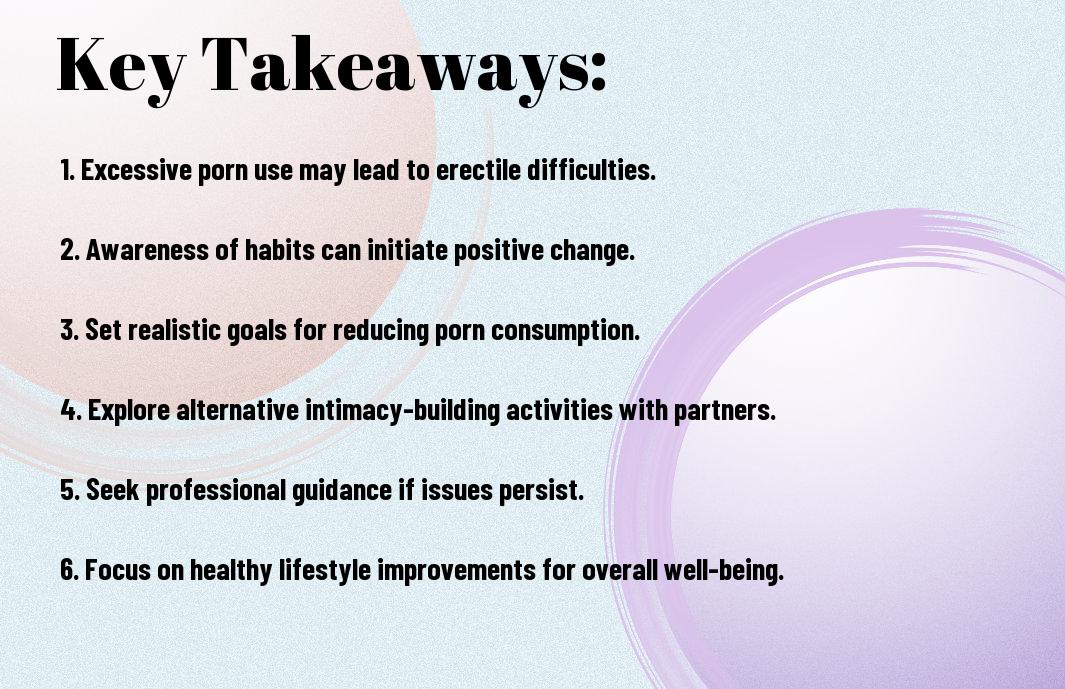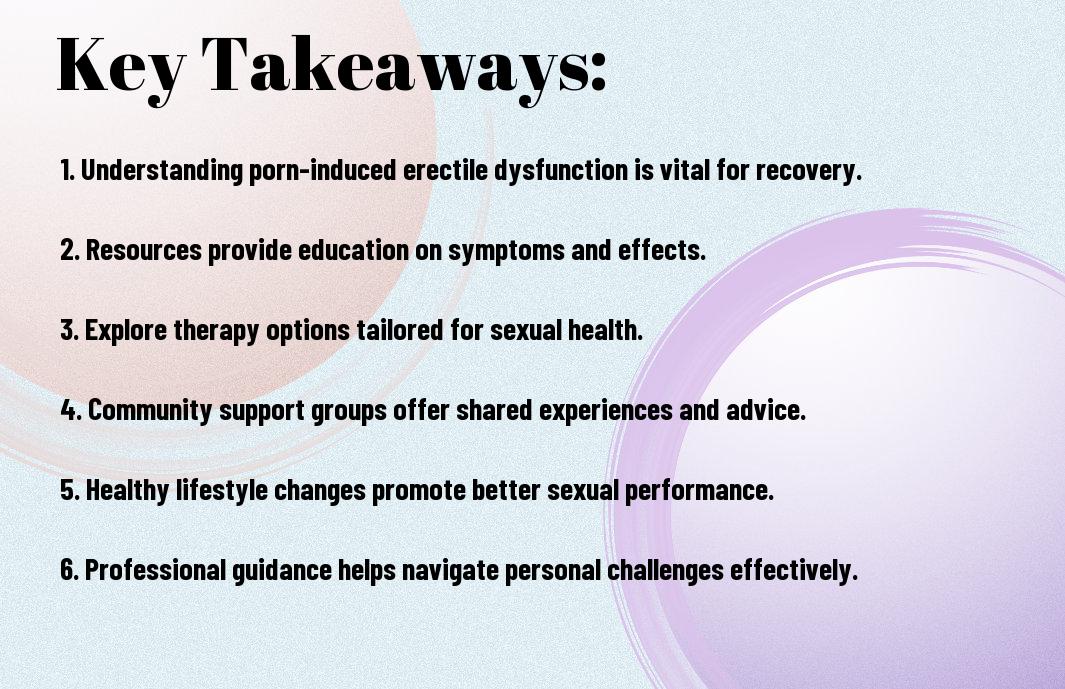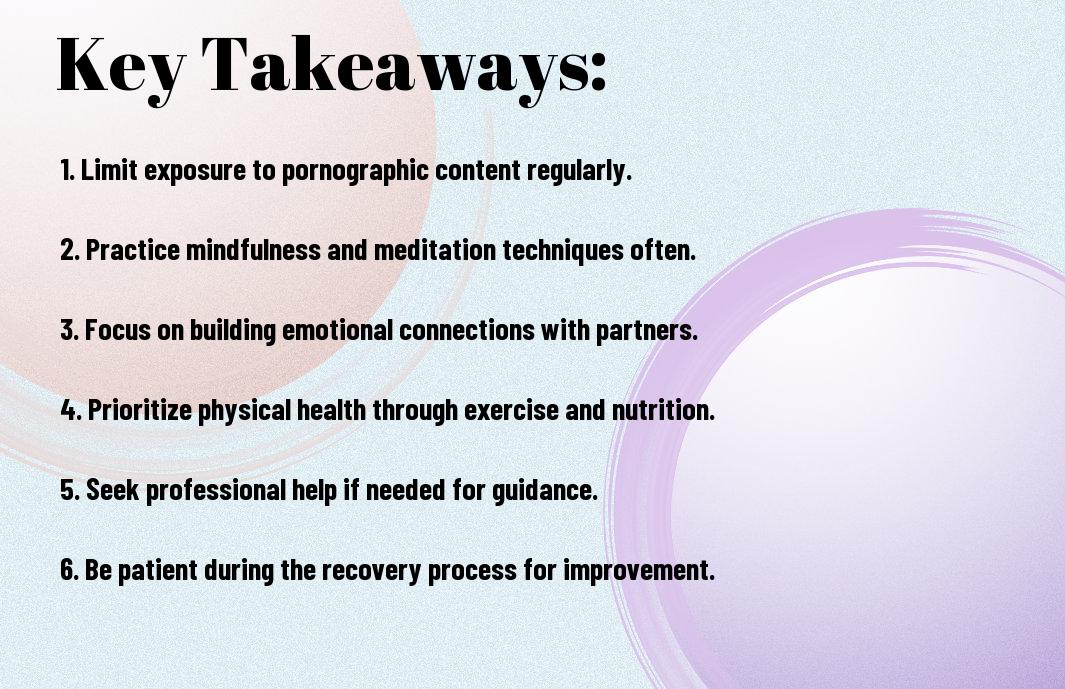There’s a growing concern about the impact of pornography on sexual health, particularly porn-induced erectile dysfunction (PIED). You aren’t alone if you’ve experienced difficulties achieving or maintaining an erection due to excessive porn consumption. This blog post will equip you with seven actionable templates specifically designed for beginners, aimed at addressing PIED and promoting healthier sexual practices. By understanding the connection between your viewing habits and erectile function, you can take proactive steps towards reclaiming your sexual well-being.
Key Takeaways:
- Porn-induced erectile dysfunction (PIED) is a growing concern that can affect sexual performance in both young and older men.
- Understanding the psychological and physiological effects of pornography on the brain is vital for addressing PIED.
- Implementing strategies such as reducing porn consumption and engaging in alternative activities can help in recovery.
- Incorporating open communication with partners and seeking professional help can enhance treatment effectiveness.
- Using templates can aid beginners in structuring conversations and approaches to tackle PIED in a practical manner.

Understanding Porn-Induced Erectile Dysfunction
The phenomenon of porn-induced erectile dysfunction (PIED) is becoming increasingly recognized among men of various ages. It refers to the difficulty in achieving or maintaining an erection due to excessive consumption of pornography. As you navigate their sexual experiences, understanding PIED may help you identify the impact of excessive porn use on your sexual health.
Definition and Overview
One of the primary concerns regarding modern sexual health is the rise of porn-induced erectile dysfunction. This term describes difficulties with arousal and erection that emerge as a result of habitual pornography consumption. If you find yourself struggling with intimacy or sexual performance, it may be a reflection of your relationship with pornography.
The Science Behind Pornography and Sexual Dysfunction
Around the world, studies indicate that excessive porn consumption can lead to significant sexual dysfunction. When you engage with porn frequently, it may shift your sexual expectations and alter your brain’s reward pathways, ultimately diminishing sexual satisfaction during real-life interactions.
Considering the neurological and psychological effects, repetitive porn use can lead to desensitization, requiring increasingly extreme stimuli to achieve arousal. This overstimulation can distort your perception of intimacy, causing challenges in real-life relationships. As you become more accustomed to the unrealistic scenarios presented in porn, it may result in difficulty responding to genuine sexual stimuli, paving the way for erectile dysfunction in sexual situations. Understanding this cycle can empower you to regain control over your sexual health.
Signs and Symptoms of Porn-Induced Erectile Dysfunction
Some common signs of porn-induced erectile dysfunction (PIED) include difficulty achieving or maintaining an erection during sexual activities, lack of sexual desire, and reliance on pornography for arousal. If you find that you are no longer responsive to real-life sexual encounters but can still become aroused by adult content, you may be experiencing PIED. It’s important to identify these symptoms early to address the underlying issues affecting your sexual health.
Identifying the Symptoms
Beside physical symptoms, you may notice emotional shifts such as anxiety or stress related to intimacy and performance. Pay attention to recurring patterns that disrupt your sexual experiences. These indicators can help you better understand your relationship with pornography and how it may be influencing your erectile function.
Psychological Impact on Individuals
With increasing reliance on porn for arousal, you might encounter significant psychological challenges, including feelings of inadequacy or shame. These sentiments can compound the issue and lead to further difficulties in sexual performance, potentially trapping you in a cycle of anxiety and decreased confidence.
Due to the mental health effects of PIED, you might find yourself withdrawing from intimate relationships or avoiding sexual encounters altogether. This avoidance can exacerbate feelings of loneliness or helplessness, and it may also contribute to lower self-esteem. By understanding the psychological impact, you can better navigate your recovery journey and seek appropriate support for both your mental and sexual health.
The Role of Pornography in Sexuality
After exploring the complexities of modern sexuality, it becomes evident that pornography plays a significant role in shaping your understanding and experience of sexual intimacy. In a world flooded with explicit content, your perceptions of pleasure, attraction, and relationships may be profoundly influenced. This reality may lead to unrealistic expectations and hinder your ability to connect deeply with partners, ultimately impacting your sexual health and well-being.
How Pornography Alters Expectations
Before watching pornography, you may have had a more genuine idea of what intimacy and attraction involve. However, frequent exposure to unrealistic portrayals of sex can lead you to expect perfection in both your looks and your partner’s performance. This shift in expectations can create feelings of inadequacy, making it harder for you to enjoy authentic connections when they arise.
The Influence of Pornography on Real-Life Relationships
Around the landscape of your romantic life, pornography can cause tension and misunderstandings. When you compare your partner to the actors you see on screen, it can breed dissatisfaction and resentment. Additionally, it may prompt unrealistic demands that compromise your relationship’s emotional intimacy and connection.
Plus, the influence of pornography on real-life relationships extends beyond just personal expectations. It can alter your views on communication, consent, and intimacy, leading to a disconnect between what you experience on-screen and what occurs in reality. This disparity might create frustration for both you and your partner, as the pressure to emulate false standards of desirability complicates your interactions. Recognizing these impacts can help you foster healthier relationships built on genuine connection and understanding.

Effective Strategies for Overcoming Porn-Induced Erectile Dysfunction
Now, understanding and implementing effective strategies to overcome porn-induced erectile dysfunction is imperative for reclaiming your sexual health. You can START HERE: Porn-Induced Sexual Dysfunction to gather resources that will support your journey. These strategies often involve a combination of behavioral changes and professional guidance to reshape your habits and restore your confidence.
Behavioral Changes
Overcoming porn-induced erectile dysfunction typically begins with significant behavioral changes in your life. Reducing or eliminating your consumption of pornography is vital, as it can help reset your sexual responses. Incorporating mindfulness techniques, engaging in physical activities, and strengthening your emotional connections with partners can further enhance your recovery and create healthier sexual experiences.
Seeking Professional Help
Before making any lifestyle adjustments, seeking professional help can be beneficial in addressing your specific needs and guiding your recovery process. A qualified therapist or counselor can provide tailored strategies and support, helping you navigate challenges related to porn-induced erectile dysfunction.
Consequently, working with a professional can facilitate deeper understanding and reflection on underlying issues contributing to your condition. Through talk therapy, cognitive behavioral techniques, or sex therapy, you stand to gain valuable insights and coping mechanisms that can enhance your journey towards a fulfilling sex life. Don’t hesitate to seek this guidance, as it can make a significant difference in your recovery.

Templates for Beginners: Practical Approaches
Once again, it’s vital to embrace practical approaches if you’re navigating porn-induced erectile dysfunction. These seven templates provide structured methods designed to support you in overcoming challenges and reclaiming your sexual health. With each template, you’ll find actionable steps to help promote healing, build intimacy, and establish a healthier relationship with yourself and others.
Template 1: Mindfulness Practices
Practical mindfulness practices can enhance your awareness and help reduce anxiety related to performance. Techniques such as deep breathing, meditation, and focusing on the present moment can create a more relaxed mindset, ultimately fostering a healthier sexual experience.
Template 2: Gradual Exposure Techniques
Before you explore gradual exposure techniques, it’s important to understand their purpose. These methods involve slowly reintroducing sexual stimuli in a controlled manner to desensitize your response and help regain confidence in intimate situations.
The goal of gradual exposure techniques is to subvert negative associations with sexual intimacy. Start by setting realistic and manageable goals, which might include small steps like engaging in intimate conversation or sharing affection without pressure. As you progress, gently increase your exposure to sexual situations, allowing yourself to take back control at your own pace.
Template 3: Building Healthy Intimacy
Template three focuses on building healthy intimacy, emphasizing the importance of emotional connection. By fostering strong emotional bonds with your partner, you can create a safe space that supports both physical and emotional intimacy without performance pressure.
It’s imperative to prioritize open communication and vulnerability in your relationships. Engage in activities that promote intimacy, such as heartfelt conversations or shared experiences, allowing you to connect on a deeper level. As trust develops, you’ll find that your comfort with physical intimacy flourishes, ultimately benefiting your sexual health.
Template 4: Journaling Emotions
Along your journey, journaling emotions provides an outlet for self-reflection and understanding. Documenting your thoughts and feelings can help identify patterns, emotional triggers, and areas that need further exploration in your healing process.
To make journaling effective, set aside time each day to write openly about your experiences and emotions related to intimacy and self-worth. This practice not only promotes emotional clarity but also encourages growth by highlighting progress over time. Engaging with your feelings through writing can lead to deeper insights and facilitate healing.
Template 5: Fostering Healthy Relationships
At the core of recovery is fostering healthy relationships with yourself and others. Surrounding yourself with supportive, understanding individuals can considerably impact your emotional well-being and confidence in intimate situations.
And investing time in nurturing these relationships is imperative. Establish open lines of communication and prioritize mutual respect and understanding. Building a network of supportive friends, family, or partners helps you feel less isolated and fosters resilience during your recovery journey. This positive atmosphere can significantly enhance your overall sexual health.
Template 6: Support Groups and Resources
Before attempting to navigate your journey alone, consider the advantages of support groups and resources. These communities provide avenues for shared experiences and learning, paving the way for healthier perspectives on intimacy and sexual health.
Relationships with others who share similar struggles can be profoundly validating. Joining support groups, whether in-person or online, allows you to connect with individuals who understand your challenges and can offer insights. Resources such as books, podcasts, and therapy can further enhance your understanding and provide guidance tailored to your needs.
Template 7: Lifestyle Changes and Habits
Beside emotional approaches, focusing on lifestyle changes and habits can significantly impact your overall well-being. Simple adjustments, such as regular physical activity, balanced nutrition, and sufficient sleep, contribute to a healthier mind and body.
Healthy lifestyle choices play a pivotal role in enhancing your sexual health. Prioritize physical activity to boost endorphin levels and reduce stress, while a balanced diet can support hormonal balance. Ensuring proper sleep hygiene also contributes to emotional resilience. Adopt these habits to cultivate a foundation for improved intimacy and sexual confidence.
To wrap up
Following this guideline, you have the tools to understand and address Porn-Induced Erectile Dysfunction effectively. By utilizing the seven templates provided, you can better navigate the challenges associated with this issue. Your journey toward restoring healthy sexual function involves self-awareness and practical steps, allowing you to take control of your sexual health. Embracing these strategies can empower you to improve your relationship with intimacy, ultimately leading to a more fulfilling sexual experience.
FAQ
Q: What is Porn-Induced Erectile Dysfunction (PIED)?
A: Porn-Induced Erectile Dysfunction (PIED) refers to the condition where an individual experiences difficulty achieving or maintaining an erection due to excessive consumption of pornography. It is often linked to the brain’s desensitization to sexual stimuli, leading to challenges in real-life sexual situations.
Q: How does excessive pornography consumption lead to erectile dysfunction?
A: Excessive pornography consumption can lead to altered brain pathways associated with pleasure and sexual arousal. Over time, individuals may find that their reaction to real-life sexual encounters is diminished, resulting in issues with achieving an erection when not stimulated by pornography.
Q: Are there specific symptoms of PIED that individuals should look out for?
A: Symptoms of PIED may include difficulty getting or keeping an erection during sexual activity, decreased libido or sexual desire, reliance on pornography for arousal, and feelings of anxiety or stress when attempting to engage in sexual intercourse without pornography.
Q: Can PIED be treated, and if so, how?
A: Yes, PIED can be treated through various strategies. These may include reducing or eliminating pornography consumption, seeking therapy to address underlying emotional issues, engaging in open communication with partners, and exploring alternative methods of sexual arousal that do not rely on visual stimuli.
Q: How long does it usually take to recover from PIED?
A: Recovery time varies for each individual and can depend on factors such as the extent of pornography use and personal commitment to change. Some individuals may notice improvements within a few weeks, while others might take several months. Consistency in adopting healthier sexual habits is key to recovery.
Q: Is PIED a common issue among men, and who is primarily affected?
A: PIED is increasingly recognized as a common issue among men, particularly younger males who have access to pornography from a young age. However, it can affect individuals of any age or gender who engage in excessive pornography consumption. Awareness and understanding are crucial for overcoming the problem.
Q: What resources are available for individuals dealing with PIED?
A: Individuals struggling with PIED can benefit from support groups, online forums, and therapy sessions focused on sexual health. Additionally, there are many educational resources and books available that investigate into understanding pornography’s impact on sexual performance and recovery strategies.








